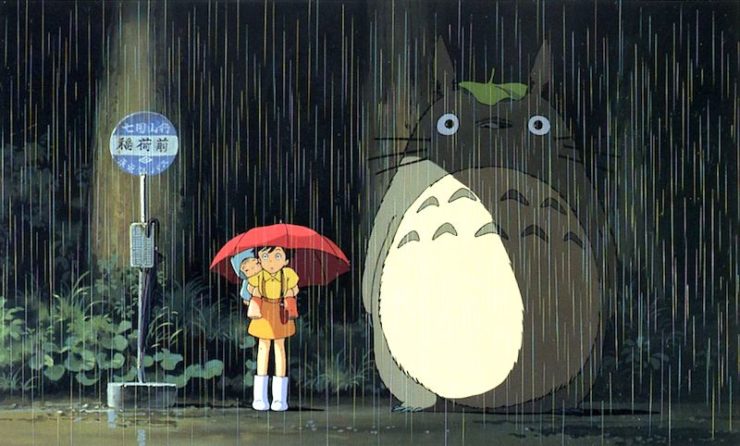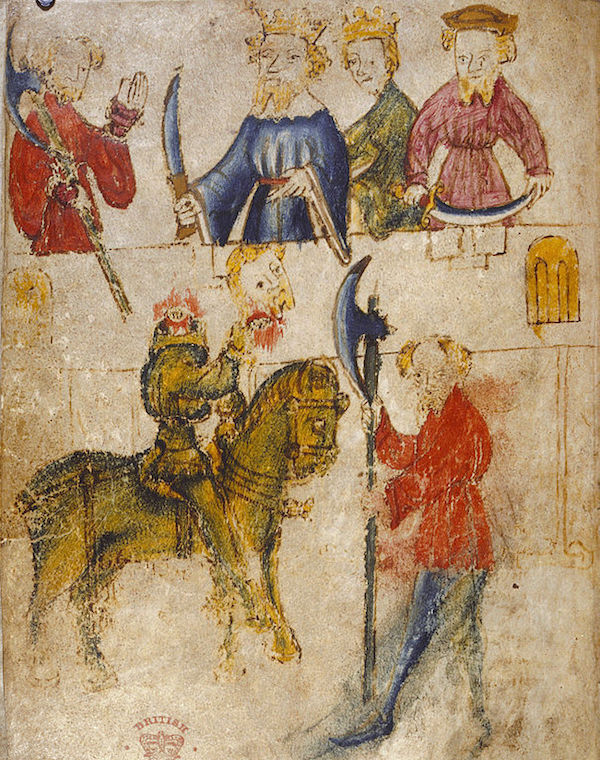The forest calls to us. It is at once breathtaking and mystical, yet foreboding and dangerous. We go “into the woods” and come out of it changed people. So it is any surprise that our ever-watchful guardian of the forest, a certain Green Man, crops up everywhere in artwork and fiction? They come with poetry, with history, with songs of old. Don’t forget that they’re waiting in the woods…
Tom Bombadil—The Lord of the Rings

The Ents count among Tolkien’s Green Man stand-ins as well, but old Tom Bombadil is certainly more… interesting. Left out of the LOTR films to the dismay of many fans, Bombadil doesn’t serve a plot purpose in Fellowship of the Ring, but he sure is fun to run into as interludes go. With his fancy lady of the river, Goldberry, and his odd yet powerful tunes, Bombadil gives the hobbits a place to nap after saving them in the Barrow-downs by frightening off a few nasty wights. With his home in the Old Forest, Bombadil remembers events on Middle-earth that no other living being can attest to—it would seem that he has always been there, and always will be. With abilities that no one quite understands, Tom stands apart from the rest of Middle-earth’s people, with Gandalf going so far as to say that the One Ring would hold no temptation for Bombadil… but he might simply misplace the darn thing.
Buy the Book


The Lord of the Rings
Someshta—The Wheel of Time

This inspiration isn’t hard to suss out, as one of Someshta’s names is “the Green Man”. A man-shaped plant person, Someshta is the last Nym, who heralds from the Age of Legends. His people were originally created for farming purposes, to sing songs to the crops that would help them to grow. Someshta himself can’t remember a great deal from the Age of Legends, with a wound in his head that has torn his memories, making it hard to even recognize people that he knows. Someshta is asked to guard the Eye of the World, not something that his kind was made for, but an important task that only he is available to do with the Aes Sedai and their male magical counterparts created it. By some people in his world, it is believed that Nyms never die so long as plants are growing.
Buy the Book


The Eye of the World
Tobias Finch—Silver in the Wood

Tobias doesn’t really remember a time before he lived in Greenhollow Wood. Or maybe he chooses not to? It’s hard to say. But he does seem to leave moss and leaves in his wake wherever he goes, and sometimes time itself seems to grow around him—and into him. And he’s never paid rent on his odd little cottage in the forest with the cat named Pearl. And his friends are dryads… In town, Tobias is known as the madman of the woods, and it is this fear that earns him a bullet wound to the leg. Luckily his curious and eager landlord—an odd young man named Henry Silver, who has a love of history and has taken quite a liking to Tobias—insists on seeing to his recovery. And if you guessed that this is where things start to go awry, well, you’d be entirely correct…
Buy the Book


Silver in the Wood
Robin Hood—various folktales and myths

While Robin Hood has many varied origins in English folklore and festivals, he owes part of his conception to the Green Man of old. It makes sense that Robin would come to be associated and intertwined with the Green Man legend, as they have a great deal in common: both make their home in the forest; both cause an undue amount of trouble; there are even some versions of Robin Hood that never seem entirely human, more woodland sprite than dispossessed yeoman or noble. Sherwood Forest itself (the IRL place in the United Kingdom) has several Green Man depictions left in ode to Robin and his band of misfits, and the place they called home. While it’s fair to say that the legend of Robin Hood would endure without the influence of the Green Man, it’s hard to be certain as to whether our Merry Man would exist in quite the same way without him.
Buy the Book


The Merry Adventures of Robin Hood
The Lorax—The Lorax

A slightly more proactive Green Man is Dr. Seuss’s Lorax, who we all know “speaks for the trees”. Released in 1971 and openly influenced by Seuss’ anger at the dangers that corporate greed poses to nature, The Lorax has withstood the test of time because its message unfortunately continues to be relevant. Nearly 40 years later, it would seem that humanity has yet to fully internalize this tiny Green (orange) Man’s message, which goes much farther than simply educating on environmental issues by delving into the problem of personal responsibility for the planet and everything on it. As the Lorax says, “Unless someone like you cares a whole awful lot, nothing is going to get better. It’s not!”
Buy the Book


Totoro—My Neighbor Totoro

A more benevolent version of a Green Man type, Totoro is called “keeper of the forest” by Mei and Satsuki’s father Tatsuo, and the label is entirely fitting for the rabbit-eared spirit. First seen by Mei, who falls asleep on top of him only to get woken up later by her sister in a briar clearing, Totoro appears when he’s needed and enjoys the wonders of nature, from the sound of raindrops on an umbrella to the rituals around planting nuts and seeds. It’s never entirely clear whether the magic that occurs around Totoro is really taking place, but the aid he gives to Mei and Satsuki while they both try to cope with the absence of their mother (who’s stuck in the hospital due to an illness) is nothing sort of nature’s divine intervention.
The Green Knight—Sir Gawain and the Green Knight

A puzzlement to scholars and literature enthusiasts the world over, the Green Knight of Arthurian legend is a figure who defies labels of all sorts. One thing is true: He is called the Green Knight because his skin is literally green. For ages scholars have tried to work out the meaning behind his appearance, but some believe it is a relatively simple form of identification: the Green Knight is green because he is a version of the Green Man. The character of the Green Knight is unpredictable, jovial, and sometimes outright demonic—if that doesn’t sound like the embodiment of nature itself, then what could? There are also the vegetative symbols to consider: his beard is compared to a bush, and he has a penchant for carrying around a holly branch. Spoiler alert—he does eventually lose his head. Spoiler alert part two—he reattaches it, as simply as if grafting plants together.
Buy the Book


Swamp Thing—DC Comics

Of all the murkier Green Man incarnations, Swamp Thing is the obvious winner, no matter who inhabits the vegetable matter of his overlarge biceps. But if we’re being honest, Alec Holland is probably the most relevant incarnation of the elemental, and his multiple deaths and resurrections certainly bear that out. Part of what’s enjoyable about Swamp Thing as a Green Man type is that he has true “plant powers” that he can use to manipulate natural surroundings, making him a god of nature in a more obvious and basic sense. He’s worked with all your DC Comics favorites, from the Green Lantern to Constantine, and it’s always a treat because he never cares about the same issues your average superhero needs to uphold. He’s there for the Green.
Buy the Book


Saga of the Swamp Thing, Volume 1
Who’s your favorite SFF Green Man?










